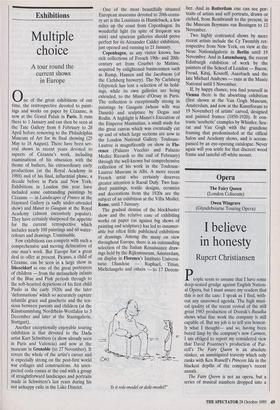Exhibitions
Multiple choice
A tour round the current shows in Europe
One of the great exhibitions of our time, the restrospective devoted to paint- ings and works on paper by Cezanne, is now at the Grand Palais in Paris. It runs there to 1 January and can then be seen at the Tate Gallery from 8 February to 28 April before removing to the Philadelphia Museum of Art for its final showing (25 May to 18 August). There have been sev- eral shows in recent years devoted to aspects of Cezanne's work, including examinations of his obsession with the theme of bathers, his extraordinary early productions (at the Royal Academy in 1988) and of his final, influential phase, a decade before in Paris and New York. Exhibitions in London this year have included some outstanding paintings by Cezanne — in Landscapes of France at the Hayward Gallery (a sadly under-attended show) and Manet to Gauguin at the Royal Academy (almost excessively popular). They have certainly sharpened the appetite for the current retrospective which includes nearly 100 paintings and 60 water- colours and drawings. Unmissable.
Few exhibitions can compete with such a comprehensive and moving delineation of one man's work. But Europe has a great deal to offer at present. Picasso, a child of Cezanne, can be seen in a large show in Diisseldorf as one of the great portrayers of children — from the melancholy infants of the Blue and Pink periods through to the soft-hearted depictions of his first child Paulo in the early 1920s and the later `deformations' which so accurately capture infantile grace and gaucherie and the ten- sions between parents and children (at the Kiinstsammlung Nordrhein-Westfalen to 3 December and later at the Staatsgalerie, Stuttgart).
Another exceptionally enjoyable touring exhibition is that devoted to the Dada artist Kurt Schwitters (a show already seen in Paris and Valencia) and now at the museum in Grenoble (to 27 November). It covers the whole of the artist's career and is expecially strong on the post-first world war collages and constructions. An unex- pected coda comes at the end with a group of straightforward landscapes and portraits made in Schwitters's last years during his not unhappy exile in the Lake District. One of the most beautifully situated European museums devoted to 20th-centu- ry art is the Louisiana in Humlebaek, a few miles up the coast from Copenhagen. Its wonderful light (in spite of frequent sea mist) and spacious galleries should prove perfect for its Alexander Calder exhibition, just opened and running to 21 January.
Copenhagen, as any visitor knows, has rich collections of French 19th- and 20th- century art from Courbet to Matisse, acquired by enlightened businessmen such as Rump, Hansen and the Jacobsens (of the Carlsberg brewery). The Ny Carlsberg Glyptotek has lent a selection of its hold- ings, while its own galleries are being extended, to the Musee d'Orsay in Paris. The collection is exceptionally strong in paintings by Gauguin (whose wife was Danish) and sculpture by Degas and Rodin. A highlight is Manet's Execution of the Emperor Maximilian, a small study for the great canvas which was eventually cut up and of which large sections are now in the London National Gallery. Toulouse- Lautrec is magnificently on show in Flo- rence (Palazzo Vecchio and Palm° Medici Riccardi to the end of February) through the well-known but comprehensive collection of his work in the Toulouse- Lautrec Museum in Albi. A more recent French artist who certainly deserves greater attention is Raoul Dufy. Two hun- dred paintings, textile designs, ceramics and decorations from the 1920s are the subject of an exhibition at the Villa Medici, Rome, until 7 January.
The gradual demise of the blockbuster show and the relative ease of exhibiting works on paper (as against big shows of painting and sculpture) has led to innumer- able but often little publicised exhibitions of drawings. Among the many on view throughout Europe, there is an outstanding selection of the Italian Renaissance draw- ings held by the Rijksmuseum, Amsterdam, on display in Florence's Instituto Universi- tario Olandese — Raphael, Titian, Michelangelo and others — to 17 Decem- `Is it role-model or dole-model?' ber. And in Rotterdam one can see por- traits of artists and self portraits, drawn or etched, from Rembrandt to the present, in the Museum Boymans van Beuingen to 12 November.
Two highly contrasted shows by more recent artists include the Cy Twombly ret- rospective from New York, on view at the Neue Nationalgalerie in Berlin until 19 November. And in Luxembourg, the recent Edinburgh exhibition of work by the painters of the School of London — Bacon, Freud, Kitaj, Kossoff, Auerbach and the late Michael Andrews — runs at the Musee National until 5 November.
If, by happy chance, you find yourself in Vienna there is the absorbing exhibition (first shown at the Van Gogh Museum, Amsterdam, and now at the Kunstforum to 19 November) of artists' carved, designed and painted frames (1850-1920). It con- trasts 'aesthetic' examples by Whistler, Seu- rat and Van Gogh with the grandiose framing that predominated at the offical Salon and Academy shows, and is accom- panied by an eye-opening catalogue. Never again will you settle for that discreet wood frame and tasteful off-white mount.


































































 Previous page
Previous page